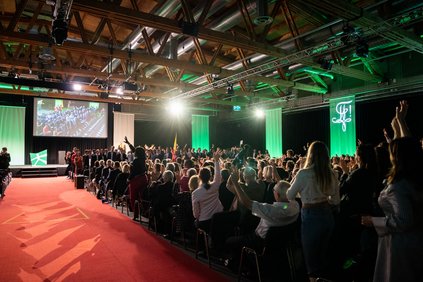Campus - 07.06.2016 - 00:00
Exchange with students from Uruguay
The Ressort International student initiative enables students to travel to a country of their choice and to experience the locals’ everyday life at first hand. In April, HSG student Tabea Stöckel spent ten days in Uruguay. She describes her experiences below.

8 June 2016. 40 students, two universities. The concept behind the Ressort International student initiative is easy to explain: one foreign university selects 20 enrolled students, who then go on an exchange with 20 students from the HSG for a ten-day stint.
Tourism with added value
The aim is to make the students aware of other countries’ cultural, political, ecological and economic peculiarities. At the same time, the students travel around the country to ensure that they do not miss out on the sights. Participants in the scheme are the guests of students from the other university. This provides them with a further insight into the other country’s culture. The projects are conducted in Europe, Asia and Latin America. From the coming year onwards, a new exchange will also be scheduled with North America.
This year, I was able to travel to Uruguay as a participant in the Magellan exchange programme. The exchange took place with the Universidad de Montevideo, a private university in the heart of the country’s capital. Uruguay is called the Switzerland of Latin America.
First contacts in Switzerland
The end of the central examinations in February this year marked the starting point for our trip: welcoming the students from Latin America in Switzerland. Those were to be ten meticulously planned days in which the students would become more familiar with Switzerland and this country’s characteristics.
The highlight for the Uruguayans was two days in Grindelwald: in front of the panorama of Jungfrau, Mönch and Eiger, half of the group braved the ski run whilst the rest took up the challenge of a fast tobogganing track. However, cultural events were also on the programme: from the Basel carnival to guided tours of cities and workshops.
In the course of time, subtle cultural differences emerged, ranging from the concept of punctuality and the issue of eating habits to an understanding of different customs or the fascination of the unusual. This resulted in lively discussions and advanced the cultural exchange within the group.
Uruguay – the importance of eating
We met again in Uruguay in early April, during our mid-term break. Lesson Number One: eating plays a much more central part in Uruguay than in Switzerland. All the culinary stops were pulled out, and we became acquainted with the national favourite dulce de leche, caramelised condensed milk, the all-purpose foodstuff par excellence. When a Swiss student asked whether dulce de leche was in the dessert, a girl said: “Never ask whether there’s dulce de leche in it, there’s always dulce de leche in it!”
The same can be said about meat, for Uruguay has more than twice the amount of agricultural land as Switzerland, and a large part of it is used for cattle breeding. We were able to experience this at first hand when we were guided through one of the country’s biggest industrial abattoirs. Cows are suspended from rails on the ceiling and were processed in a production line. Nothing for weak stomachs, particularly as it was followed by a burger tasting session.
Everyone was highly enthusiastic about Cabo Polonio, a small fishing village without electric power, which is located on the borders of a national park and can be reached with special lorries. Camp fires on the beach and surfing lessons on the morning’s breakers in an idyllic dunescape enchanted everyone.
No matter how impressive it was to explore a country with such intensity in ten days, the actual experience was the exchange with the other students and the insights that it provided.
Tabea Stöckel is a student in the second semester of the Assessment Year.
More articles from the same category
Discover our special topics











